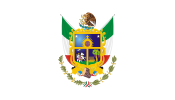State flags of Mexico
Most Mexican states do not have an official flag. For these states, a de facto flag is used for civil and state purposes, the flags have a 4:7 proportion ratio and typically consist of a white background charged with the state's coat of arms.[1]
At least seven states have official flags: Baja California Sur, Durango, Guerrero, Jalisco, Querétaro, Quintana Roo and Tlaxcala. Except for Jalisco and Tlaxcala, each official flag is simply a white background charged with the state's coat of arms.
Two states have provisions in their constitutions explicitly declaring that there shall be no official state flag. These states are Baja California[2] and Campeche.[3]
Official state flags[]

Baja California Sur
(adopted December 31, 2017)[4]
Durango
(adopted March 9, 2014)[5]
Guerrero
(adopted October 25, 2019)[6]
Jalisco
(adopted February 22, 2007)[7]
Querétaro
(adopted September 22, 2015)[8]
Quintana Roo
(adopted October 8, 2013)[9]
Tlaxcala
(adopted October 30, 2011)[10]
Official coat of arms as state flag[]

Tamaulipas
(adopted December 15, 2011)[11]
Gallery[]
Flag of Quintana Roo
See also[]
References[]
- ^ CRW Flags; Mexico; retrieved May 2016
- ^ "Constitución Política" (PDF). bajacalifonia.gob.mx. Gobierno del Estado. Retrieved May 20, 2016. Per Chapter 3, Article 6, "there shall be no other flags ... of official character" (No habrá otros banderas ... de carácter oficial).
- ^ "Constitución Política" (PDF). campeche.gob.max. Gobierno del Estado. Retrieved May 20, 2016. Per Chapter 2, Article 5, "there shall be no other flags ... of official character" (No habrá otros banderas ... de carácter oficial).
- ^ "Ley sobre el Escudo, la Bandera y el Himno del Estado de Baja California Sur". www.cbcs.gob.mx (in Spanish). Gobierno del Estado. Archived from the original on April 11, 2020. Retrieved December 31, 2017.The state flag is described in Chapter 2, Articles 3.
- ^ "Ley sobre el Escudo, la Bandera y el Himno del Estado de Durango". durango.gob.mx (in Spanish). Gobierno del Estado. Retrieved May 15, 2016. The state flag is described in Chapter 3, Articles 10 through 15.
- ^ "Ley sobre el Escudo, la Bandera y el Himno del Estado de Guerrero". guerrero.gob.mx (in Spanish). Gobierno del Estado. Archived from the original on April 11, 2020. Retrieved October 15, 2019. The state flag is described in Chapter 3, Articles 10 through 761.
- ^ "Ley sobre el Escudo, Bandera e Himno del Estado de Jalisco" (PDF). jalisco.gob.mx (in Spanish). Congreso del Estado. Archived from the original (PDF) on August 8, 2014. Retrieved April 28, 2016.
- ^ "Ley de Escudo, la Bandera y el Himno del Estado de Querétaro" (PDF). legislaturaqueretaro.gob.mx (in Spanish). LVIII Legislatura del Estado de Querétaro. Retrieved April 28, 2016.
- ^ "Ley sobre la Bandera del Estado de Quintana Roo" (PDF). congresoqroo.gob.mx (in Spanish). Poder Legislativo. Retrieved April 29, 2016. The date of adoption is given in "Se Iza por Primera Vez la Bandera de Quintana Roo". Cancun Digital (in Spanish). Archived from the original on March 13, 2016. Retrieved April 28, 2016.
- ^ "Reseña histórica de la bandera de Tlaxcala". e-consulta.com Tlaxcala. 2017-04-21.
- ^ "Ley sobre el Escudo y el Himno de Tamaulipas" (PDF). tamaulipas.gob.mx (in Spanish). Gobierno de Tamaulipas. Retrieved December 15, 2011. The law does not explicitly declare a state flag. Instead, Article 3 states that the state's coat of arms can be represented in the form of a flag (puede representarse en forma de Bandera) and gives rules on how the coat of arms shall appear when used in that form. The article specifies that the flag shall consist of the coat of arms on a white background, and gives further physical specifications. Chapter 4 (Articles 7 through 18) gives rules regarding the use of the coat of arms when it is in the form of a flag (en su modalidad de Bandera).
- Flags of Mexico
- States of Mexico
- Lists and galleries of flags
- Flags of country subdivisions









